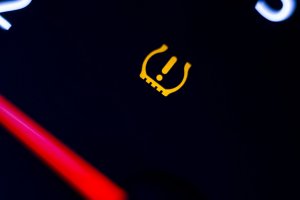When it comes to safe driving, tire pressure matters. According to AAA, low tire pressure can reduce your braking distances and make your car less responsive. This can be especially dangerous if you find that you must make an emergency stop or perform a sudden maneuver.
Most people know that a car’s tire pressure light will come on when the vehicle’s tires are low – but how do you watch for pressure that’s too high? What’s the ideal tire inflation level? And should you keep a pressure gauge on hand?
In this post, we’ll discuss the ins and outs of checking your own tires, including how (and how often) to do it.
Let’s dive in.
What to do When a Tire Pressure Light Comes on
Tire pressure warning lights are usually on the dashboard of a car, in or near the speedometer. The warning lights are typically red or yellow in color, and usually resemble a side-view of a tire, with an exclamation point. Here’s an example of what your warning light might look like:

If your low tire warning light comes on, follow these steps:
- Pull over to the nearest gas or service station
- Check the pressure on all four tires (and the spare, if applicable)
- Add air to any tires that fall below the range listed on the tire itself
- Once the tires are inflated, watch the light
- If it doesn’t turn off after about 10 miles, visit a local auto mechanic. The tire monitor may need to be reset.
To keep yourself safe and avoid undue wear and tear on your tires, keep a tire gauge handy in your car at all times.
How Frequently Should You Check Your Tire Pressure?
At a minimum, we recommend you check the inflation of your tires at least once a month. Today’s tires lose about one pound per square inch (PSI) of inflation each month after you’ve filled them. By checking your tires monthly, you can avoid deflation and keep your car running strong.
If you live in a hot climate where the temperature fluctuates quickly or you have new tires, you may want to check your PSI more often. Hot weather increases the air pressure in tires. In fact, every 10 degrees the temperature rises will actually increase your pressure by one PSI. Over-inflated tires can wear unevenly and may even burst in extreme situations.
DeBroux: Your Source for Auto Maintenance in Pensacola
If you’ve overlooked your tires, or been unsure how to maintain their PSI, you’re not alone. Lots of us only think about our tires when we need new ones. The fact, however, is that keeping your tires properly inflated is critical to your safety on the road.
If you’re looking for a team to help you maintain and care for your vehicle, DeBroux Automotive is here for you. Our team can help fit your vehicle with new tires, keep each tire properly inflated, and keep your car running strong for years to come.
Ready to learn more? Contact us today.
